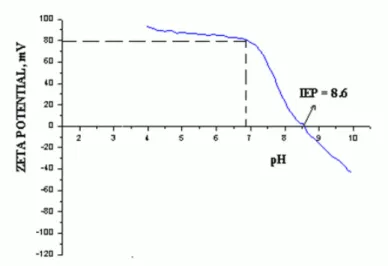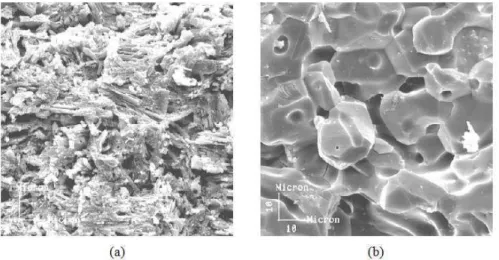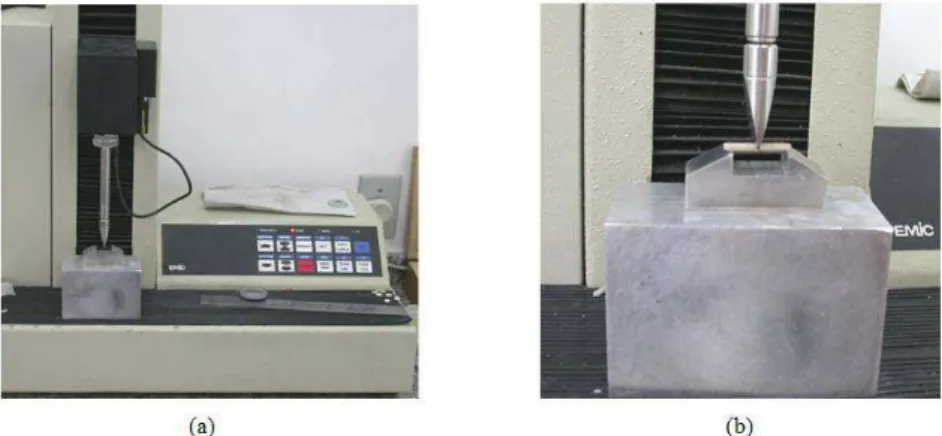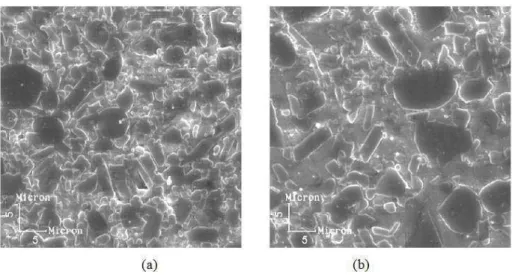http://www.materia.coppe.ufrj.br/sarra/artigos/artigo10904
Influence of handling and heating cycle on the morphology and flexural
strength of glass-infiltrated alumina bars
DA SILVA, F.T. I; BARBEJAT, A. II; FILHO, H.S. III
I
Federal University of Rio de Janeiro, Brazil, PEMM-COPPE/UFRJ Ilha do Fundão, Rio de Janeiro, RJ. CEP: 21941-972
e-mail: flatesi@metalmat.ufrj.br
II
Estácio de Sá University, Rio de Janeiro, Brazil e-mail: abarbejat@terra.com.br
III
University of Rio de Janeiro State (UERJ), Rio de Janeiro, Brazil e-mail: hsampaiofilho@superig.com.br
ABSTRACT
The main goal of the present study was to evaluate the influence of plaster stability, handling and thermal cycling on the morphology and mechanical strength of glass infiltrated alumina bars. Two different slip casting/thermal processing routes were investigated. The highest flexural strength of alumina bars from In-Ceram£Alumina protocol in comparison to In-Ceram£Sprint protocol was mainly due to its low drying rate and less handling. After glass infiltration and mechanical surface treatments, In-Ceram®Sprint alumina bars presented a non-homogeneous distribution of alumina particles in the glass phase, which was the mais cause for its lower flexural strength. In both cases, it was observed a strong anisotropic growth of alumina particles after glass infiltration. Non-reproducible mechanical surface treatments is other factor that could deteriorate the mechanical strength of alumina bars.
Key-words: Glass infiltration, alumina bars, flexural strength.
1 INTRODUCTION
Due to its high mechanical strength and biocompatibility, dental ceramics is one of the main choices for crowns or fixed partial dentures [1, 2]. However, its low fracture toughness limits its applications, in comparison to metals or special alloys [3]. In order to increase its uses and reduce costs, porcelains over metal named metal-ceramics, has been used extensively for the last three decades. Actually, the main aim for dental prosthesis is substituting the metallic substructure for a ceramic one, which allows high strength, aesthetics and biocompatibility [4].
A method for making all-ceramic dental prosthesis having high strength and low shrinkage was patented by Tyszblat,M. [5] which consisted of a partially sintered alumina framework further infiltrated by a glass phase. One of the most interesting aspect of this process, is its near-net shape processing. Based on this route, VITA Zahnfabrik patented two different routes called In-Ceram®Alumina and In-Ceram®Sprint. In both cases, an alumina crown is prepared by brushing a 65 vol% alumina slip on the surface of a special plaster mold, followed by partial sintering and glass infiltration. It is important to point out that handling and heating cycle of both routes are significantly distinct.
Mechanical surface treatments of those glass infiltrated frameworks are commonly used to remove the excess glass and to make size adjustments. The influence of grinding on its mechanical strength are contradictory [6, 7]. It can be explained by taking in account the combined effect of surface flaws and residual stresses, the ratio of crack length to surface compression layer depth, the dimensions of pre-existing flaws and other factors. In spite of its low impact energy, sandblasting tend to create some strengthening and micro retentive regions in its surface increasing cement adhesion to the framework [8,9]. Polishing tend to promote some strengthening based on a similar patented mechanism as sandblasting, that is by generating surface compressive stresses and by removing pre-existing flaws or radial cracks.
propagation [12]. Clinical performance of In-Ceram Alumina is relatively scarce and some contradictory. Sorensen et al. [13] recommend that this system could be used with confidence for anterior fixed partial dentures and patented von Steyern et al. [14] reported a 90% success of three unit posterior fixed partial denture of In Ceram Alumina after five years.
2 MATERIALS AND METHODS
The chemical composition of alumina and infiltration glass frit powders determined by X-ray fluorescence, are shown in table 1. The alumina particle size varied between 2.5-10.0 ȝm with some submicrometric. The morfology of alumina was basically isotropic.
Table 1: Chemical composition of alumina and infiltration glass frit powders
Alumina Weight %
Al2O3 99.70
MgO 0.03
Infiltration Glass Frit Weight %
La2O3 49.60
Al2O3 20.00
SiO2 19.10
TiO2 6.16
CaO 3.14
Others 2.00
In order to prepare a well dispersed concentrated alumina slip (38g Al2O3 in 5ml aqueous solution)
at room temperature, it was necessary to identify if in this conditions the alumina particles were well deffloculated. The stability of alumina slip was confirmed by the zeta potential X pH graph. As shown in figure 1, the zeta potential of alumina slip at pH (pH = 6.8) was approximately + 80m, indicating well dispersed conditions.
Figure 1: Zeta potential X pH of alumina in aqueous solution. IEP – Isoelectric point of alumina
to complete its heating cycle. Figure 4 shows In-Ceram®Alumina and In-Ceram®Sprint partial sintering cycles.
Figure 2: Molding alumina bar by slip casting over a plaster mold
Figure 3: (a) Microestruture of plaster plate at the end of drying; (b) Microestruture of plaster plate after partial sintering
Figure 4: In-Ceram®Alumina and In-Ceram®Sprint partial sintering heating cycles
In order to remove the excess glass and to adequate the alumina bars dimensions to the ISO 6872 standard, ten bars of each processing route were grinded, sandblasted and polished. Figure 5 shows the alumina bar being tested in the equipment EMIC MFDL 500 (load cell of 500N and crosshead speed 0,5 mm/min). The reliability of flexural strength data was evaluated through Weibull statistics.
Figure 5: (a) Flexural test equipment EMIC MFDL 500. (b) Detail of the alumina bar being tested (b)
3 RESULTS AND DISCUSSION
Infiltrated alumina bars presented a mean flexural strength (555MPa) higher than In-Ceram Sprint (430MPa). This behavior was mainly due to handling and to the different heating cycles. The high drying rate and handling in In Ceram Sprint route, are probably the main causes for its lower strength. Figure 6 shows the Weibull plot for the flexural strength of In-Ceram Alumina bars. These results indicate some scattering of experimental data (m = 6.5). The flexural strength corresponding to 63% cumulative probability of failure was 600MPa.
Figure 6: Weibull distribution of infiltrated alumina bars (In-Ceram Alumina)
Figure 7 shows the scanning electron microscopy of an alumina bar before and after glass infiltration. The anisotropic growth of alumina after lanthanum glass infiltration is clearly seen. The lanthanum glass does not have the classical network modifiers (alkaline and alkaline-earth), but in this case La2O3 act as a glass modifier decreasing its viscosity.34 (raquel). These glasses have interesting mechanical
Figure 7: Scanning electron microscopy of fractured non-infiltrated (a) and an infiltrated alumina bar (b). Observe the anisotropic growth of alumina after glass infiltration.. Bar length - 2ȝm
Figure 8: Scanning electron microscopy of polished glass infiltrated alumina bars. (a) In-Ceram®Alumina , (b) In-Ceram® Sprint
Compairing the mechanical strength, pore size distribution and microstructure of infiltrated alumina (In-Ceram® Alumina and In-Ceram® Sprint) with the one from Lee,D.Y. et al. [15], it was observed that they were very similar. Guazzato et al. [16] reported a slightly higher mean flexural strength of In-Ceram® Alumina (594MPa). The influence of different mechanical surface treatments (grinding, sandblasting and polishing) on the mechanical strength of glass-infiltrated alumina dental ceramic was reported by Guazzato,M. et al.(6). It was shown that grinding and sandblasting promote a severe damage on dental prosthesis mainly during excess glass removal. Despite the use of a water coolant, Swain and Hannink [17] dealing with zirconia, observed that an excessive heat generated during grinding could promote changes in its microstructure. In this case, this heating could promote crack healing which did not occurred during sandblasting.
It is important to point out that in both routes, it was observed a strong anisotropic growth of alumina after glass infiltration (figure 8). The capillary glass flow through the open porosity of partially sintered alumina and the solution/precipitation of alumina in the glass phase are the main causes for its high anisotropic growth. Guo et al [18] suggest that solid state diffusion of La3+ in Al2O3 at high sintering
temperatures may form needlelike LaAl11O18 . Maciel,A.P et al. [19] also observed needlelike formation of
LaAlO3 from the solid state reaction between La2O3 and Al2O3 of at approximately 14000C. In the present
work, in spite of the lower glass infiltration temperature (11000C), a possible diffusion of La3+in Al2O3 lattice
4 CONCLUSIONS
Due to the low drying rate and less handling, In-Ceram£Alumina (group 1) presented the higher mean flexural strength and reliability;
Due to its high drying rate and relatively impervious plaster mold due to the insulation gel film, In-Ceram Sprint present a more opened structure; the glass phase penetrating in a great amount in the porous alumina promote a significant decrease in mechanical strength due to the lower strength of the glass phase;
The flexural strength of all sample groups were influenced by mechanical surface treatment for excess glass removal. The high dispersion of flexural strength data of both groups were mainly due to glass infiltration and mechanical surface treatments for excess glass removal;
The strong anisotropic growth of alumina particles during glass infiltration was mainly due to the interaction between alumina and the liquid phase. The solubility of alumina in the glass phase and the influence of temperature on its solubility, may possibly explain the impressive anisotropic growth of alumina particles.
5 REFERENCES
[1] HASELTON, D.R., DIAZ, A.M., “Clinical assessment of high-strength all-ceramic crowns”, Journal
Prosthetic Dentistry, v. 83, pp. 396-401, 2000.
[2] OTTL, P., PIWOWARCZY, A., KLIWOWARCZYK, A., LAUER, H.C., HAGENBARTH, E.A., “The procera allceram system”, Int J Periodontics Restorative Dent., v. 20, pp. 151-61, 2000.
[3] CALLISTER,W.D., Materials Science and Engineering: An Introduction, 5th ed. New York: John Wiley 2000.
[4] DOUGLAS, R.D., PRZYBYLSKA, M., “Predicting porcelain thickness required for dental shad matches”, Journal Prosthetic Dentistry, v. 82, pp. 143-149, 1999.
[5] TYSZBLAT, M., Process for the Preparation of a Dental Prosthesis by Solid Phase Fritting of a Metal
Oxide Based Infrastructure, US Patent: 4, 772, 436, 1987.
[6] GUAZZATO, M., ALBAKRI, M., QUACH, L., SWAIN, M.V., “Influence of grinding, sandblasting, polishing and heat treatment on the flexural strength of a glass-infiltrated alumina-reinforced dental ceramic”, Biomaterials, v. 25, pp. 2153-2160, 2004.
[7] GIORDANO, R., CIMA, M., POBER,R., “Effect of surface finish on the flexural strength of feldsphatic and aluminous dental ceramics”, Journal Prosthodontics,v. 8, pp. 311-319, 1995.
[8] KERN, M., THOMPSON, V.A., “Sandblasting and silica coating of a glass-infiltrated alumina ceramic: Volume loss, morphology and changes in surface composition”, Journal of Prosthetic Dentistry, v. 71, pp. 453-461, 1994.
[9] KERN, M., THOMPSON, V.A., Bonding to glass infiltrated alumina ceramic: Adhesive methods and their durability, Journal of Prosthetic Dentistry, v. 73, pp. 240-249, 1995.
[10] SEGHI, R.R., SORENSEN, J.A., Relative flexural strength of six new ceramic materials, International
Journal Prosthodontics, v. 8, pp. 239-246, 1995.
[11] WAGNER, W.C., CHU, T.M., “Biaxial flexural strength and indentation fracture toughness of three new dental core ceramics”, Journal of Prosthetic Dentistry, v. 76, pp. 140-144, 1996.
[12] GUAZZATO, M., ALBAKRY, M., SWAIN, M.V., IRONSIDE, J., “Mechanical properties of in-ceram Alumina and in-ceram zirconia”, Internationa Journal of Prosthodontics, v. 15, pp. 339-346, 2002.
[13] SORENSEN, J.A., KANG, S.K., TORRES, T.J., KNODE, H., “In-ceram fixed partial denture: Three year clinical results”, Journal of Californian Dental Association, v. 26, pp. 207-214, 1998.
[15] LEE, D.Y., KIM, D.J., KIM, G.Y., SONG, Y.S., “Effect of alumina particle size and distribution on infiltration rate and fracture toughness of alumina-glass composites prepared by melt infiltration”,
Materials Science and Engineering A, v. 341, pp. 98-105, 2003.
[16] GUAZZATO, M., ALBAKRY, M., RINGER, S.P., SWAIN, M.V., “Strength, toughness and microstructure of a selection of all-ceramic materials: Part–I pressable and alumina glass-infiltrated ceramic”, Dental Materials, v. 20, pp. 441-448, 2004.
[17] SWAIN, M., HANNINK, R., “Metastability of the martensitic transformation in a 12mol% ceria – zirconia alloyii. grinding studies”, Journal of American Ceramic Society, v. 71, pp. 1358-1364, 1989.
[18] GUO, R., GUO, D., CHEN, Y., YANG, Z., YUAN, Q., “In situ formation of LaAl11O18 rodlike particles
in ZTA ceramics and effect on mechanical properties”, Ceramics International, v. 28, pp. 699-704, 2002.
[19] MACIEL, A.P., LEITE, E.R., LONGO, E., VARELA, J.A., “Sol-gel modified method for obtaining Į -alumina nanocoated with rare-earth”, Ceramica, v. 51, pp. 52-57, 2005.



